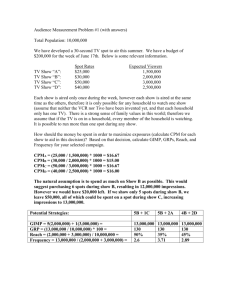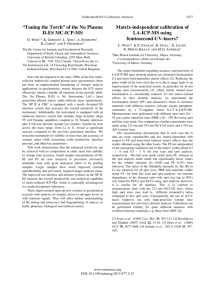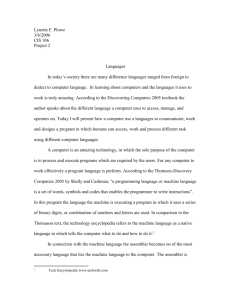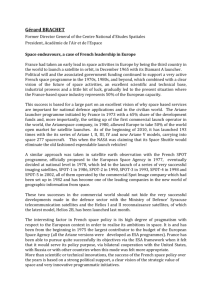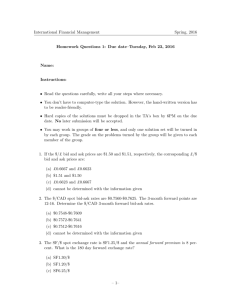Bills Notes Bonds
advertisement
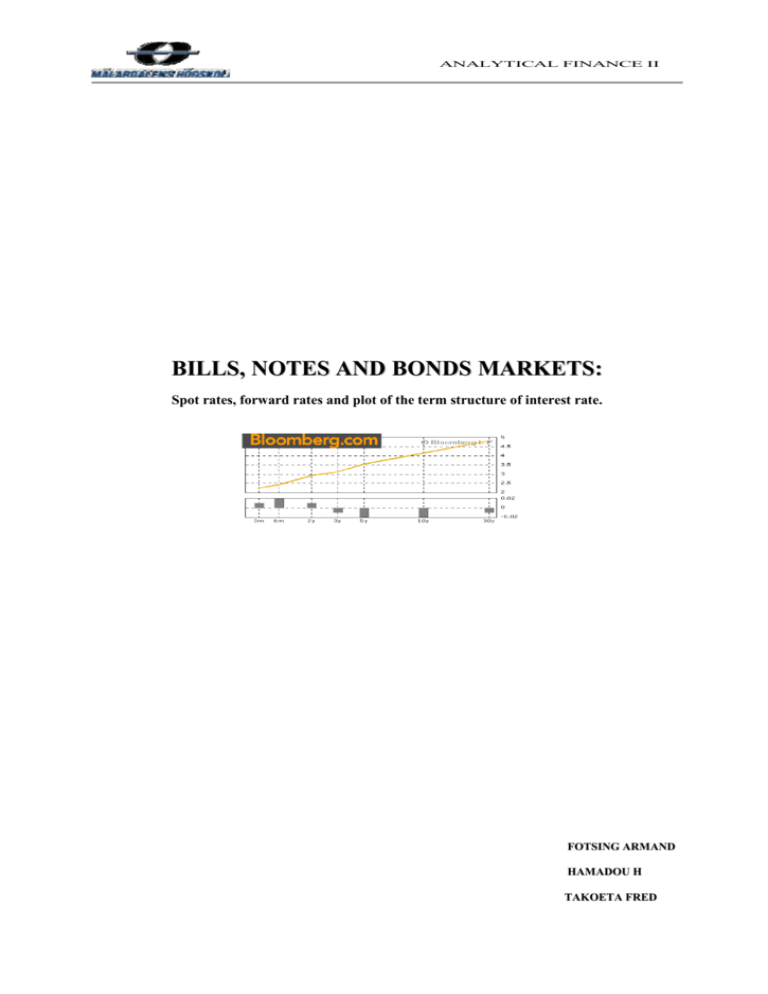
ANALYTICAL FINANCE II BILLS, NOTES AND BONDS MARKETS: Spot rates, forward rates and plot of the term structure of interest rate. FOTSING ARMAND HAMADOU H TAKOETA FRED 1 2 3 INTRODUCTION:............................................................................................................. 3 1.1 Background ................................................................................................................ 3 1.2 Objective: ................................................................................................................... 3 LITERATURE REVIEW AND THEORY: ....................................................................... 4 2.1 Bills ............................................................................................................................ 4 2.2 Notes........................................................................................................................... 5 2.3 Bonds .......................................................................................................................... 5 2.4 Spot Rate .................................................................................................................... 6 2.5 Forward Rate .............................................................................................................. 7 DATA PRESENTATION & ANALYSIS ......................................................................... 8 3.1 4 5 Striping the Instruments: ............................................................................................ 9 RESULTS......................................................................................................................... 10 4.1 Term structure of interest rate: ................................................................................. 10 4.2 Spot Rates:................................................................................................................ 10 4.3 Forward Rates: ......................................................................................................... 12 CONCLUSION ................................................................................................................ 13 References .................................................................................................................... 14 Appendix ...................................................................................................................... 15 2 1 INTRODUCTION: This first part of our report present the background information of our study on one hand, and go ahead to disclose the objectives we intend to achieve in our report. 1.1 Background One way investors spend their money in a safe way is by lending their money to the government. This achieved by buying Treasury bonds, bills or notes. These securities can be purchased directly from the government at auctions or by paying the fees involved to buy them from a bank or brokerage. In an economy and mostly in developed economies, governments issue bills, notes and bonds as an excellent risk-free way to preserve capital, or to get an attractive return and keep one’s investment liquid. On the government part, these securities are debt instruments sold to raise money to operate the government and pay off debt. These so called treasury securities are a safe investment because they are backed by the central government. Investing in treasury bonds, bills and notes has a lot of advantages, however, the biggest advantage of investing in treasuries is that it is easy and there is virtually very little or no risk involved. Their safety lies in the fact that they are obligations of the government and the probability that the government will break a promise on you is quite close to zero. In other words, in the world of securities investing of the various forms treasuries are as close to a certain item as one will ever get. They provide steady income along with convenience, flexibility, and uncommon safety.. 1.2 Objective: Based on the above rises our interest in surveying this area (bonds, bills and notes) of security investment. We have structure this research paper therefore to provide answers to the following research objectives: . 3 >Select a market for Bills, Notes and Bonds: to attain this objective we have selected for the above-mentioned securities mainly the German market, given the availability of the data for that market. >Estimate the spot and forward rates: using appropriate formulas available in the literature and using the MS Excel software, we will work out the forward and the spot rate from the German market data. >Plot the term structure of the interest rates: we will finally use the values obtained to plot the Term Structures of the Spot and the Forward Rates. However, in order to achieve our objectives we want to take a step to survey the literature pertaining to our research issues. 2 LITERATURE REVIEW AND THEORY: This section explores the short story of the different securities under consideration. The section starts by presenting Bills, and then continues with exploring Notes, before ending by portraying Bonds in the last part. 2.1 Bills A bill is an instrument where only the nominal amount is paid or received at expiry with a lifetime normally a year or less. The instrument is traded before expiry at a discount of the nominal amount. These are short-term securities that mature in one year or less, and are available for buying for less than face value. When the bill matures, the holder receives its face value. For example, if an investor buys a SEK10,000 26-week T-bill for SEK9,750. If the investor decides to hold it until maturity, she will be paid SEK10,000. The extra SEK250 is the interest she earned from her investment.. . 4 2.2 Notes Treasury notes are intermediate securities which maturities range from one to 10 years. They are marketable securities that pay interest semiannually mature in two to 10 years, while Treasury bonds mature in 10 to 30 years. Both notes and bonds pay a fixed rate of interest every six months until the security matures. Face value is repaid at maturity. T-Notes are a lot like T-Bonds. Like T-Bonds, T-Notes are exempt from government and local taxes and offer greatest safety to the investors because they are backed by the central government, they pay low interest rates as well and are sold in most case like in the US by the Central Banks (Federal Reserve Bank).. 2.3 Bonds A bond is essentially a loan. Whenever an investor buys a bond, she is lending her money to someone mostly to the government or to a large company. The principal lent or the obtain amount of the bond is called its face value. In exchange, the investor will receive regular interest payments, called coupons. The length of the loan is the bond's maturity, the bond expires or come due on its maturity or expiry date, at which time its entire value is repaid plus the interest in last period are repaid. Depending on who is issuing the bond, bonds can be categorized as follows: Government bonds (issued by government and government agencies), Corporate bonds (issued by corporations), we also have bonds issued by the local state or by foreign governments. In general, there are seven types of bonds with different properties: treasuries, government agencies, mortgage-backed securities, municipal bonds, zero coupon bonds, investment grade corporate and high yield bonds1 On the overall regarding the theory and literature part, we can say that bills, notes and bonds are transferable that can be bought and sold in the securities market. They are also sold through . 1 http://www.teenanalyst.com/bonds/bondsnotesbills.html 5 competitive and noncompetitive bidding at auctions. In this regard, many financial newspapers report auction schedules. 2.4 Spot Rate A spot interest rate for maturity m is an interest rate payable on a spot loan of maturity m that accumulates interest to maturity. Spot rates are also called zero-coupon rates because they are the rates of interest payable by zero coupon bonds. Libor rates for maturities of a week or more are spot rates. Figure 2.1: Spot Curve indicates £ Libor rates for monthly maturities as of March 1, 2004. A spot curve (or zero coupon curve) is a graph of spot rates as a function of maturity. Figure 2.1: Spot Curve Source: http://www.riskglossary.com/articles/fixed_income_term_structure.htm An n (n + m) forward rate is an interest rate payable on a forward loan that commences n months from the spot date, matures m months after that, and accumulates interest to maturity.. If we have a spot curve, we can calculate forward rates. Suppose we want the £35 forward Libor rate for March 1, 2004. We can calculate this from the 3-month and 5-month spot Libor rates. Let r denote the desired forward rate. We use the fact that a 5-month spot loan is . 6 financially equivalent to a 3-month spot loan combined with a 35 forward loan. With Libor, simple compounding is used. Based on the 3-month and 5-month spot rates and day counts as of March 1, we conclude: (1 + .0112(92/360)) (1 + r (61/360)) = (1 + .0115(153/360)) [1]2 Solving for r, we obtain the forward rate as 1.19%. Note that this exceeds both the spot rates, which are 1.12% and 1.15%. This makes sense. The combined interest from the 3-month spot and forward loans must equal the interest earned on the 5-month spot loan. If the rate earned on the 3-month spot loan is lower than that earned on the 5-month spot loan, then the rate earned on the forward loan will have to be greater than that earned on the 5-month spot loan2. 2.5 Forward Rate A forward curve is a graph of forward rates all for the same maturity, but with different forward periods. For example, a forward curve might indicate rates for 03, 14, 25, 36, 47, ... , 120123 forward loans. This would be called a 3-month forward curve. Figure 2.1 indicates a 1month forward curve calculated from the spot rates of Figure 2.13 If we have a spot curve, we can calculate forward rates. Suppose we want the £35 forward Libor rate for March 1, 2004. We can calculate this from the 3-month and 5-month spot Libor rates. Let r denote the desired forward rate. We use the fact that a 5-month spot loan is financially equivalent to a 3-month spot loan combined with a 35 forward loan. With Libor, simple compounding is used. Based on the 3-month and 5-month spot rates and day counts as of March 1, we conclude.3 (1 + .0112(92/360)) (1 + r (61/360)) = (1 + .0115(153/360)) [1] 2 Source: http://www.riskglossary.com/articles/fixed_income_term_structure.htm 7 Solving for r, we obtain the forward rate as 1.19%. Note that this exceeds both the spot rates, which are 1.12% and 1.15%. This makes sense. The combined interest from the 3-month spot and forward loans must equal the interest earned on the 5-month spot loan. If the rate earned on the 3-month spot loan is lower than that earned on the 5-month spot loan, then the rate earned on the forward loan will have to be greater than that earned on the 5-month spot loan. 3 A forward curve is a graph of forward rates all for the same maturity, but with different forward periods. For example, a forward curve might indicate rates for 03, 14, 25, 36, 47, ... , 120123 forward loans. This would be called a 3-month forward curve. Figure2.2 indicates a 1month forward curve calculated from the spot rates of Figure 2.13 Figure 2.1: Forward & Spot Curves 3 DATA PRESENTATION & ANALYSIS From www.Bloomerg.com, we selected data from the German market for Bills, Notes and Bonds. The data are available for a period ranging from 3 months to 30 years. However due to time and other constraints, we will consider data on this market for the period from 3 months to 10 years. Bloomberg is worldwide financial communication company which provides an unparalleled combination of data, analysis, electronic trading and straight-through processing 8 tools on a single platform, to Bloomberg Television®, to Bloomberg Radio in magazines and online.4 The data used in our report are for bill and notes and bonds and discloses the following information that has be used to compute our target forward and spot rates and finally plot the different term structures. The data illustrate the coupon, the yield to maturity, the price of the bond and even more information like change in time that we will not make use of in order to attained the objectives stated in the first part of this report. The data as described are presented in the appendix at the end of our report. 3.1 Striping the Instruments: Striping the instruments that is the securities prices into two components (interest and principal) will help us to separate the interest and the principal to obtain the zero-coupon bonds. This process is useful in a situations where the coupon is unknown and has to be calculated from the security’s own price. In the course of this project, the coupon has already bean revealed, so we will not do any striping or bootstrapping in our project.. 4 http://about.bloomberg.com/about/ourco/overview.html . 9 4 RESULTS This section basically presents the results obtained from the computation performed in Excel giving our data. We first present the results for the Spot rate and plot its Term Structure; the section ends up with the table results and the Term Structure of the forward rate. 4.1 Term structure of interest rate: Also known as the yield curve, it is a very common bond valuation method. It is constructed by graphing the yield to maturities and the respective maturity dates of benchmark fixed-income securities; the yield curve is a measure of the market's expectations of future interest rates. Term Structure of Interest Rates Figure 4.1. Term Structure of Interest Rate 4 3,5 3 YTM 2,5 2 1,5 1 0,5 0 0 2 4 6 8 10 12 Maturity 4.2 Spot Rates: We estimated the spot rate of the bond. The spot rate is the abstract yield on a zero-coupon Treasury. We calculate the spot rate by bootstrapping. To show how we calculate the spot rate, consider data from table 4.1. The first three bonds pay no coupons, the spot rates. can be calculated directly using the formula (continuously compounding). . 10 P i 1 Ci xp Ri Ti F Cn xp Rn Tn i n 1 where F= Principal (Nominal) Value Ri= Spot rate Rn= Spot rate to be calculated. P= Bond Price Ci = Coupon i 1,2,..., n - 1 Ti = Year Table 4.1: Calculated Spot Rates Year Coupon Yield(Red) Dirty price Principal Spot Rate 0,025 0 2,17 99,62 100 0,1523 0,5 0 2,14 99,13 100 0,0175 1 0 2,21 100,53 100 -0,0053 2 2,25 2,33 99,85 100 0,0349 3 4,5 2,47 105,19 100 0,0424 4 3,5 2,7 102,88 100 0,0362 5 3,5 2,89 102,68 100 0,0363 6 5,25 3,1 111,71 100 0,0400 7 5 3,26 110,79 100 0,0401 8 4,5 3,4 107,66 100 0,0399 9 10 4,25 3,75 3,51 3,61 105,63 101,13 100 100 0,0402 0,0403 Figure 4.2: Term Structure of Spot Rate Term Structure of Spot Rates 0,1800 0,1600 0,1400 Spot Rate 0,1200 0,1000 0,0800 0,0600 0,0400 0,0200 0,0000 -0,0200 0,03 0,5 1 2 3 4 5 6 7 8 9 10 . Maturity 11 Figure 4.2 represents the term structure of spots rates. From the graph we see that the spot rate decreases sharply for bills and notes i.e. maturities between 0 and 1 year. After the one year period,the spot rate increases for bonds with maturity up to 5 years and then remain almost at a constant rate for bonds with maturity above 5 years. Thus the longer the maturity of a bond, the lesser its spot rate becomes. 4.3 Forward Rates: A forward rate specifies an interest rate to be paid on an obligation beginning on some future date. We next compute the forward using our previously estimated spot rates using the following formula.: 1 rt 2forward t1 t 2 t 2 t1 (1 rt spot 2 ) 1 spot t1 (1 rt1 ) Table 4.1: Calculated Forward Rates Year Coupon Yield(Red) Dirty price Forward Rate 0,025 0 2,17 99,62 0 0,5 0 2,14 99,13 0,018 1 0 2,21 100,53 -0,011 2 2,25 2,33 99,85 0,071 3 4,5 2,47 105,19 0,133 4 3,5 2,7 102,88 0,153 5 3,5 2,89 102,68 0,195 6 5,25 3,1 111,71 0,265 7 5 3,26 110,79 0,317 8 4,5 3,4 107,66 0,368 9 10 4,25 3,75 3,51 3,61 105,63 101,13 0,426 0,484 Figure 4.3 below represents the term structure of forward. From the graph we see that the forward rate decreases sharply for bills and notes i.e. maturities between 0 and 1 year. After the one year period,the forward rate increases at a continuous rate as maturity increases. Thus the longer the maturity of a bond, the higher its forward rate. . 12 Term Structure of Forward Rate 0,6000 Figure 4.2: Term Structure of Forward Rate. 0,5000 Forward Rate 0,4000 0,3000 0,2000 0,1000 0,0000 0,5 1 2 3 4 5 6 7 8 9 10 -0,1000 Maturity 5 CONCLUSION To summarize, it is important that we recall the problem under investigation in order to assess whether we have attained the objectives stated at the beginning of our project. Our main objectives were to select a market for Bills, Notes and Bonds, to estimate the spot and forward rates from the pool of data using appropriate formulas available in the literature, and finally to plot the term structure of the spot and the forward rates. In order to achieve our goals, we started by taking a look at the basic literature and review of important concepts then we presented the data from which we have been able to estimate the spot and the forward rates as well as the plot of their term structure. . 13 References John C. Hull (2003) Options, Futures and Other Derivatives, Fifth Edition, Prentice Hall, Upper Saddle River Lecture Notes: Jan Roman http://about.bloomberg.com/about/ourco/overview.html Source: http://www.riskglossary.com/articles/fixed_income_term_structure.htm 14 Appendix 15


